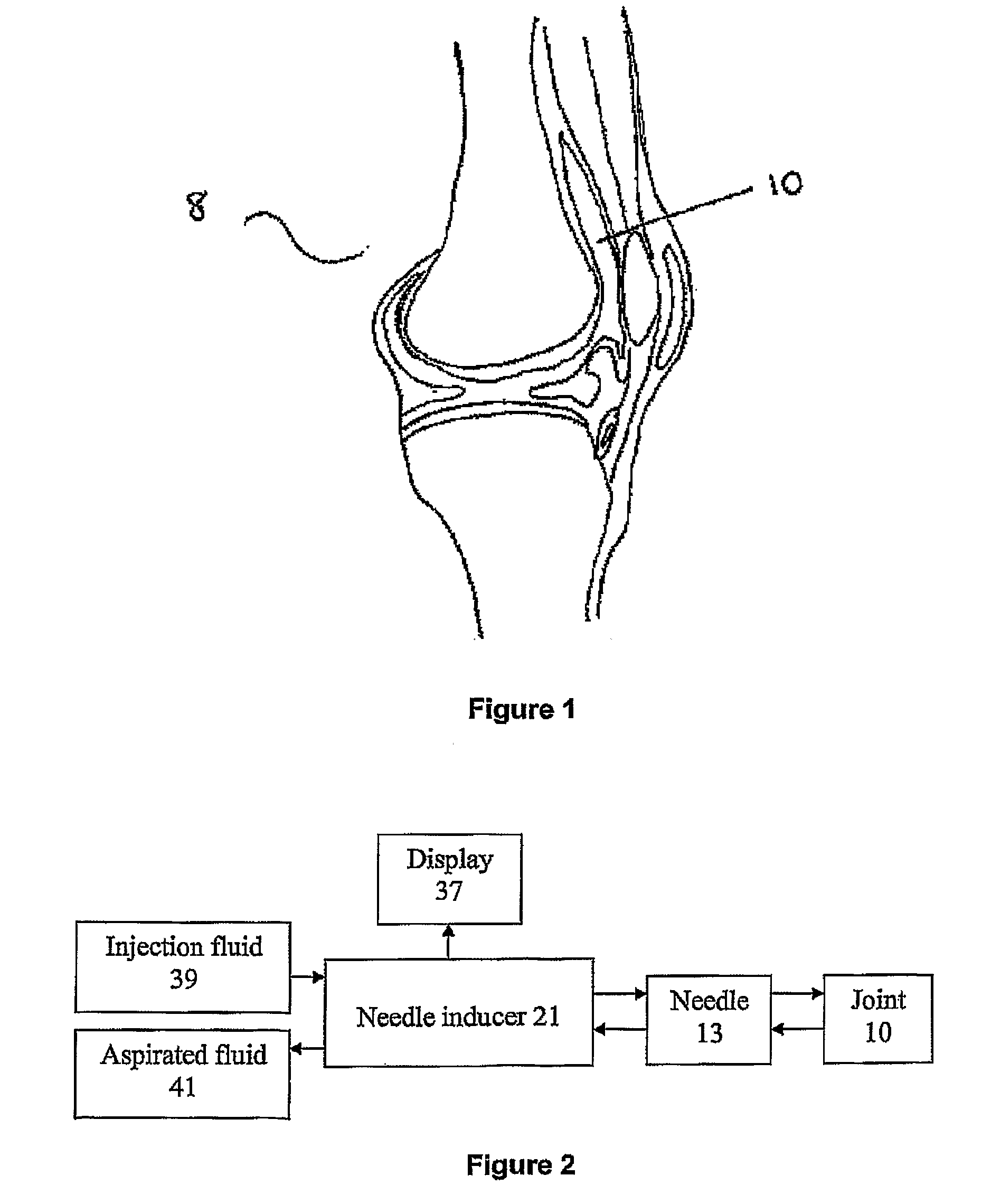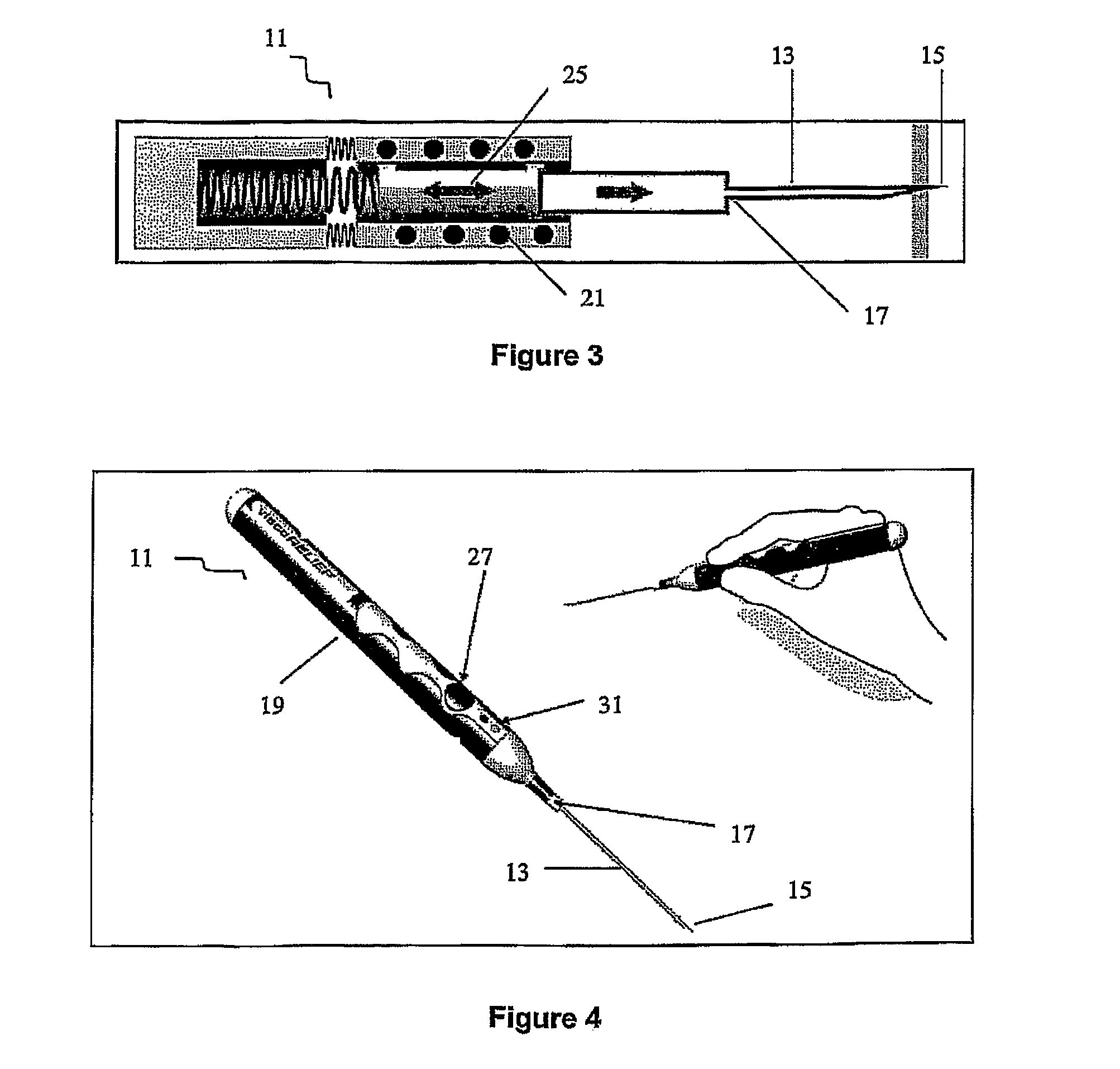Method and apparatus for intra-articular injection or aspiration
a technology of intraarticular injection and aspiration, which is applied in the field of fluid exchange within the joint, can solve the problems of pain and swelling in the patient's joint, difficulty in correctly locating and difficulty in correct positioning the needle tip in the synovial cavity
- Summary
- Abstract
- Description
- Claims
- Application Information
AI Technical Summary
Benefits of technology
Problems solved by technology
Method used
Image
Examples
first embodiment
[0125]FIG. 1 is a schematic of the anatomy of a knee joint 8. Referring to FIGS. 1 and 2, the invention is in the form of a medical apparatus 11 for performing Visco supplementation. FIG. 2 is a block diagram of a medical apparatus 11 according to an embodiment of the invention. The apparatus 11 comprises a hollow piercing member, in the form of a needle or cannula 13 through which a fluid may pass. The needle / cannula 13 has a first end 15 adapted to pierce the skin of a patient, and a second end 17 releasably secured to a body 19. The body 19 incorporates an inducer 21 to induce pulses within the apparatus 11
[0126]The apparatus 11 also comprises a sensing means 23 wherein upon entering a cavity of the patient the sensing means 23 senses pulse differentials which result when the first end 15 of the needle / cannula 13 enters the cavity. Such as the synovial joint cavity 10 shown in FIG. 1.
[0127]A first embodiment of the invention is shown in FIGS. 3, 4, and 5a. In this embodiment the...
second embodiment
[0128] the force pulse is generated by eccentrically mounting a fly wheel 29 within the body 19, as shown in FIG. 5b.
[0129]In both the first and second embodiments the force pulse is generated by the inertia effects of the mass 25 and flywheel 29 respectively. When the first end 15 of the needle / cannula 13 enters a region of different viscosity such as the cavity, the change in inertial kickback is experienced. This change provides a physical indication to the operator that the first end 15 is in the cavity. The sensing means 23 in the form of an accelerometer 24 also senses the change and a visual indicator 31 on the body 19 indicates to the operator that the cavity has been entered.
third embodiment
[0130]Referring to FIGS. 7 to 12, the invention is shown. In this embodiment the pulses are in the form of pressure pulses which are induced in the fluid travelling through a tube 33 which is in fluid communication with the needle / cannula 13. The pressure pulses form at a known frequency and pressure.
[0131]The sensing means 23 in this embodiment is in the form of a transducer 35 which measures the change in resistance at the first end 15 of the needle / cannula 13.
[0132]Referring to FIGS. 9 and 10, the apparatus 11 is connected to a display unit 37, which incorporates a pump unit 38, a saline bag 39 and an effusion bag 41. The display of the display unit 37 may take many forms, an example of which is shown in FIG. 11. On this display is an indicator lamp 43 which is highlighted when first end 15 enters the cavity.
[0133]The pump unit 38 comprises two peristaltic pumps 45, each designated to either move fluid out the saline bag 39 or into the effusion bag 41 to ensure there is no cross ...
PUM
 Login to View More
Login to View More Abstract
Description
Claims
Application Information
 Login to View More
Login to View More - R&D
- Intellectual Property
- Life Sciences
- Materials
- Tech Scout
- Unparalleled Data Quality
- Higher Quality Content
- 60% Fewer Hallucinations
Browse by: Latest US Patents, China's latest patents, Technical Efficacy Thesaurus, Application Domain, Technology Topic, Popular Technical Reports.
© 2025 PatSnap. All rights reserved.Legal|Privacy policy|Modern Slavery Act Transparency Statement|Sitemap|About US| Contact US: help@patsnap.com



